高中英语语法:替代的用法课件(共43张PPT)
文档属性
| 名称 | 高中英语语法:替代的用法课件(共43张PPT) |  | |
| 格式 | zip | ||
| 文件大小 | 180.2KB | ||
| 资源类型 | 教案 | ||
| 版本资源 | 通用版 | ||
| 科目 | 英语 | ||
| 更新时间 | 2019-05-31 19:53:58 | ||
图片预览

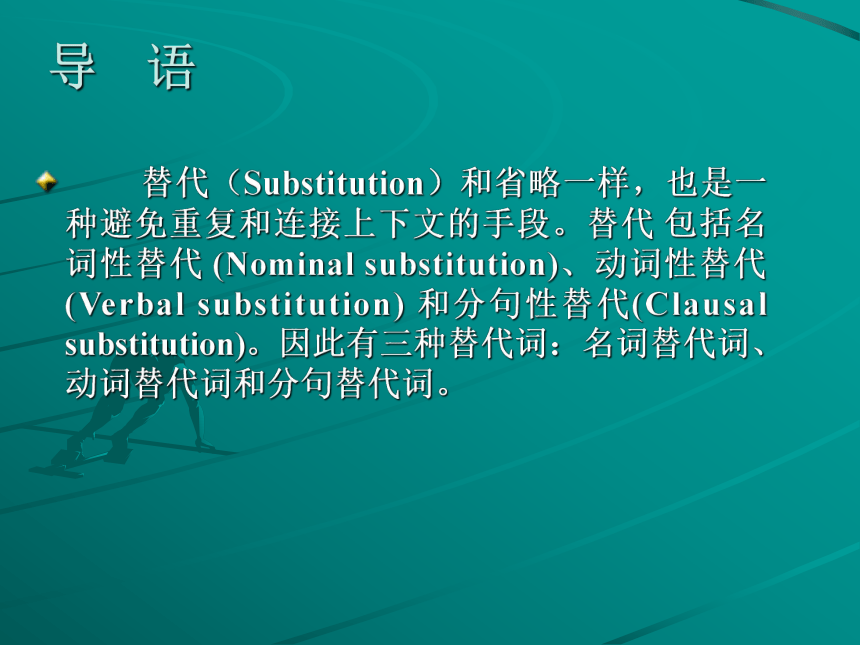
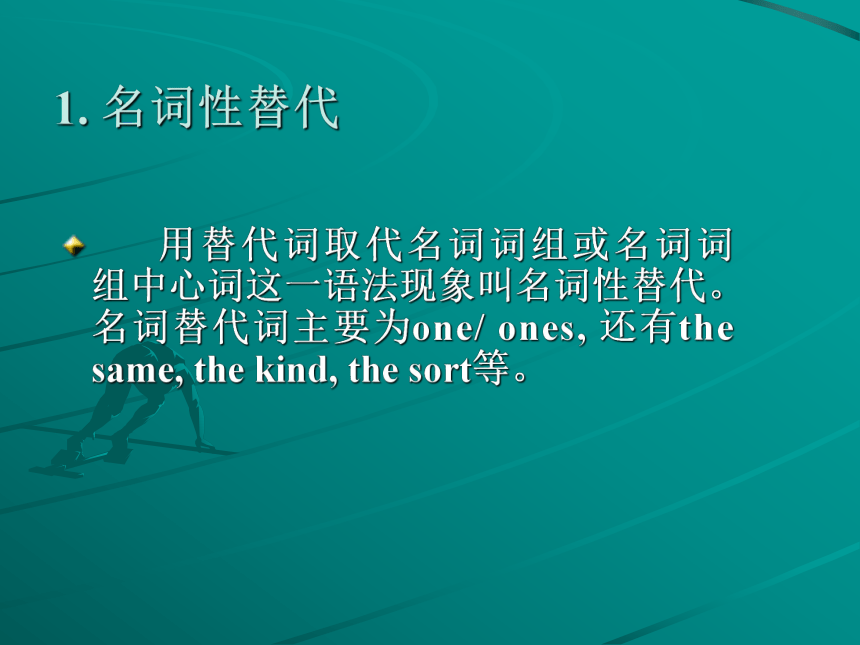

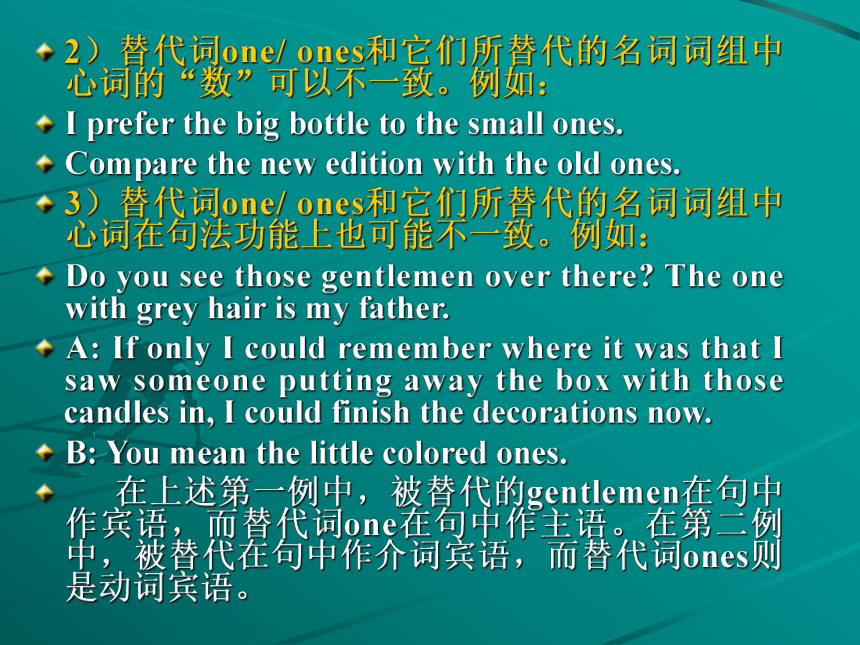

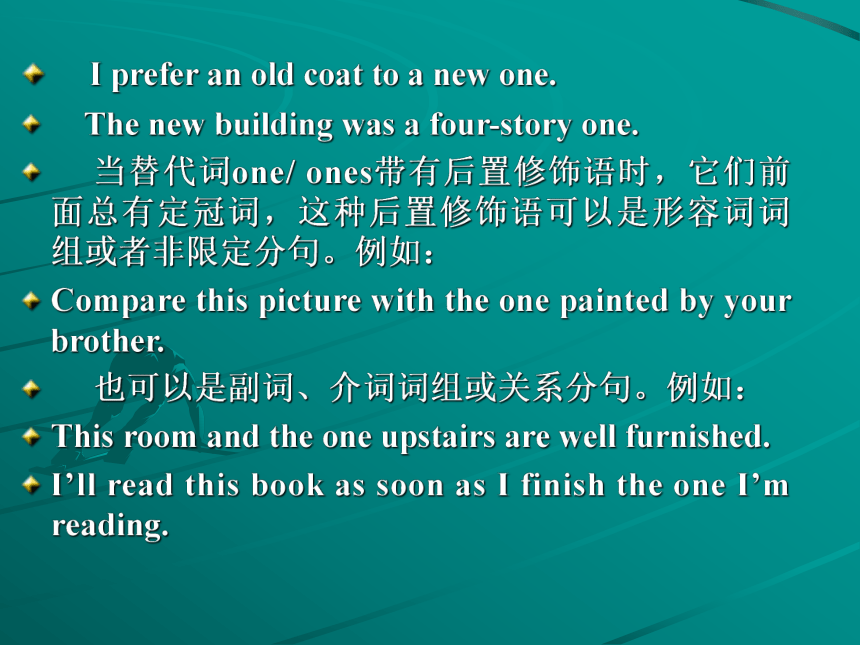
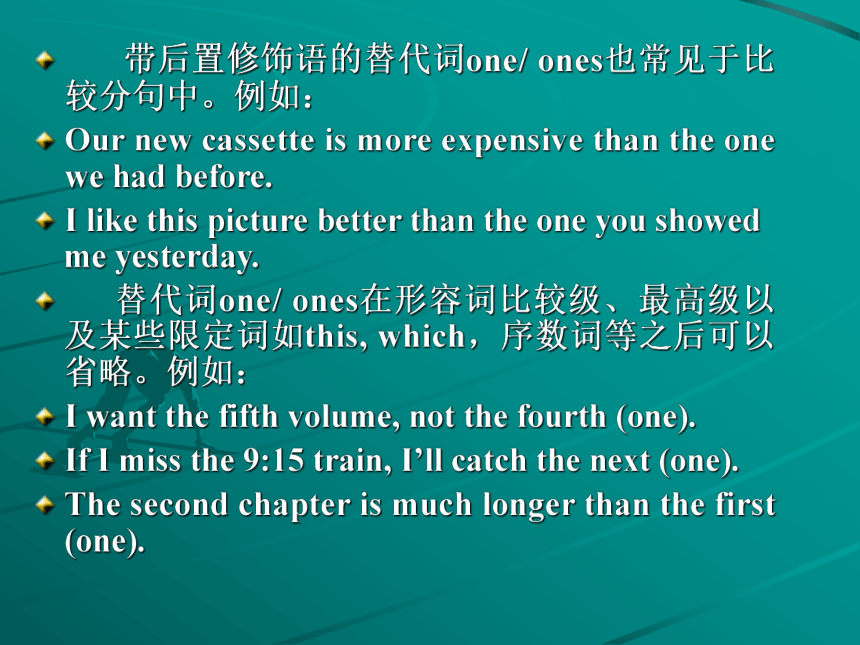


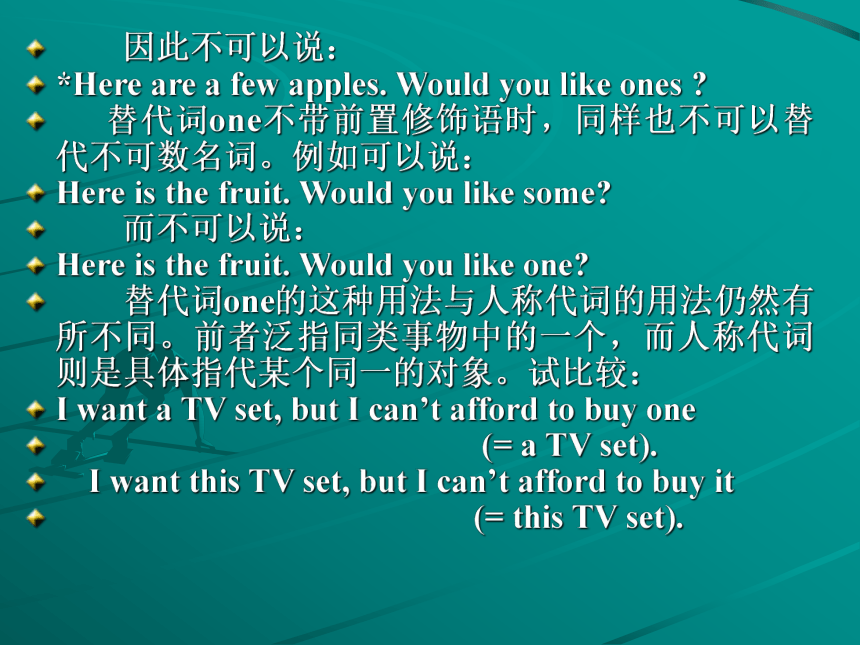

文档简介
课件43张PPT。替 代导 语 替代(Substitution)和省略一样,也是一种避免重复和连接上下文的手段。替代 包括名词性替代 (Nominal substitution)、动词性替代 (Verbal substitution) 和分句性替代(Clausal substitution)。因此有三种替代词:名词替代词、动词替代词和分句替代词。1. 名词性替代 用替代词取代名词词组或名词词组中心词这一语法现象叫名词性替代。名词替代词主要为one/ ones, 还有the same, the kind, the sort等。1. A 替代词one/ ones的用法1)替代词one/ ones只能替代单数/复数可数名词。例如:
There are good films as well as bad ones. (ones = films)
They sent us a lot of small apples instead of big ones. (ones = apples)
如果名词词组中心词是不可数名词,就不能用one/ ones替代,要避免重复,通常采用名词性省略:
We prefer green tea to black (tea).
I like fresh candy better than stale (candy).2)替代词one/ ones和它们所替代的名词词组中心词的“数”可以不一致。例如:
I prefer the big bottle to the small ones.
Compare the new edition with the old ones.
3)替代词one/ ones和它们所替代的名词词组中心词在句法功能上也可能不一致。例如:
Do you see those gentlemen over there? The one with grey hair is my father.
A: If only I could remember where it was that I saw someone putting away the box with those candles in, I could finish the decorations now.
B: You mean the little colored ones.
在上述第一例中,被替代的gentlemen在句中作宾语,而替代词one在句中作主语。在第二例中,被替代在句中作介词宾语,而替代词ones则是动词宾语。4)替代词one/ ones一般带有修饰语,它们和所替代的名词中心词所指不一定是同一对象,这是替代词one/ ones用法上一个重要特征。例如:
I don’t like this book. I’d like a more interesting one.
I’d like to have some big apples instead of small ones.
在上述第一例中,one虽然等于book,但“这本书”和“更有趣味的书”显然不是同一对象:同样地,第二例中的ones虽然等于apples,但“小苹果”和“大苹果”所指也并非一物。其所以所指对象不同是因为替代词one/ ones通常带有表示对比含义的修饰语。
替代词one/ ones所带的修饰语可以前置,也可以后置。前置修饰语一般是限定词和形容词,通常带有重音,表示对比含义。例如: I prefer an old coat to a new one.
The new building was a four-story one.
当替代词one/ ones带有后置修饰语时,它们前面总有定冠词,这种后置修饰语可以是形容词词组或者非限定分句。例如:
Compare this picture with the one painted by your brother.
也可以是副词、介词词组或关系分句。例如:
This room and the one upstairs are well furnished.
I’ll read this book as soon as I finish the one I’m reading. 带后置修饰语的替代词one/ ones也常见于比较分句中。例如:
Our new cassette is more expensive than the one we had before.
I like this picture better than the one you showed me yesterday.
替代词one/ ones在形容词比较级、最高级以及某些限定词如this, which,序数词等之后可以省略。例如:
I want the fifth volume, not the fourth (one).
If I miss the 9:15 train, I’ll catch the next (one).
The second chapter is much longer than the first (one). 替代词one/ ones通常不用在名词属格之后,也不用在形容词性物主代词+ own之后。例如可以说:
This is my house and that’s Peter’s.
不可以说:
*This is my house and that’s Peter’s one.
可以说:
I don’t like to live long in a foreign country; I want to go back to my own
不可以说:
*I don’t like to live long in a foreign country; I want to go back to my own one. (5)替代词如果不带任何前置修饰语,即它的前面既没有限定词也没有形容词时,便不是替代名词中心词而是替代整个名词词组。例如:
The question is one (= a question) of a great importance.
If you want a friend, you’ll find one (= a friend) in me.
由上述诸例可以看护粗,替代词one的这种用法是泛指同类事物中的任何一个,相当于不定冠词,因此它没有复数形式。要泛指复数的事物,只能用some。试比较:
Here are a few apples. Would you like one (= an apple)?
Here are a few apples. Would you like some (= some of them)? 因此不可以说:
*Here are a few apples. Would you like ones ?
替代词one不带前置修饰语时,同样也不可以替代不可数名词。例如可以说:
Here is the fruit. Would you like some?
而不可以说:
Here is the fruit. Would you like one?
替代词one的这种用法与人称代词的用法仍然有所不同。前者泛指同类事物中的一个,而人称代词则是具体指代某个同一的对象。试比较:
I want a TV set, but I can’t afford to buy one
(= a TV set).
I want this TV set, but I can’t afford to buy it
(= this TV set). 上述第一例如果改用it便是病句。
* I want a TV set, but I can’t afford to buy it.
因为it和它所代替的名词词组所指为同一对象,应带定冠词或其他特指限定词,但上文的名词词组没有特指意义,因而只能用one,不能用it。
要注意区别替代名词词组的one,替代名词词组中心词的one和数词one。试比较:
A: Can I have those apples?
B: You have already got one (= an apple).
(在这里,重音落在got上,one不重读,如果重读便成为数词。)
You’ve already got a red one(= an apple). (在这里,重音落在red上,one不重读,替代名词词组中心词。)
You can have one; give the rest to your little brother.
(这句的one要重读,它是数词,表示“一个”。)
还要注意区别替代词one与不定人称代词one。如前所述,不定人称代词one泛指“人”,相当于any person(包括说话人和对方在内),只有单数形式,也不带修饰语,通常单独使用,构成名词词组,只作句子的主语,并有属格one’s和反身形式oneself。one的这种用法与替代词one在意义上是完全不同的。例如:
One should do one’s / his duty.
If one wants to know a thing, one/ he ought to come into contact with it.
One can’t be too careful, can one/ he?1. B 其他名词替代词1)替代词the same的用法
the same可用作整个名词词组的替代词,通常指物,但与它所替代的名词词组并非指同一对象。例如:
A: I’ll have two poached eggs on toast, please.
B: I’ll have the same.
在这里,the same并非表示the same eggs,而是替代在上文作宾语的整个名词词组two poached eggs on toast,当然不可能共指第一个说话人所要的那份荷包蛋土司。 替代词the same一般不可以再带有修饰语,但可以带有表示保留或条件的后置修饰语。例如:
A: I’ll have two poached eggs on toast, please.
B: I’ll have the same but fried.
I’ll have the same without the fried.
A: I’d like a cup of tea.
B: I’d like the same with milk but without sugar. 规章等正式文体中,替代词the same有时也可以和它所替代的词语共同指一个对象。例如:
The society shall keep minutes of its proceedings, which shall be available for public inspection. From time to time it shall publish the same.
在这里,the same = the minutes of its proceedings,所指之物相同。
替代词the same在一定搭配中可以替代一个名词性分句所表示的事实。例如:
A: John thought it was impossible.
B: Yes, I thought the same. (= that it was impossible)
有时,the same所替代的仅是某个分句所表示的基本事实,细节略有变更。例如: We can trust Caroline. I wish I could say the same of her husband. (= that we can trust her husband)
替代词the same在另一些搭配中可以表示上文中的某个变化过程。例如:
A: That noise really unnerves me.
B: Yes, it does the same to me too. (does the same = unnerves me)
当替代词the same用作主语补语时,它所替代的词语可以是名词词组,也可以是形容词词组或比较结构等。例如:
Charles is now an doctor. Given half a chance I would have been the same. (the same = an actor) 2)替代词kind和sort的用法
kind和sort通常用来替代不可数名词。例如:
American food is not the same as the English kind. (kind = food)
Slang disappears quickly, especially the juvenile sort. (sort = slang)
除了名词性替代外,不定代词each, none, all, some, any, either, neither, both等也可起类似作用,已在有关章节讲过,此处不再重复。2. 动词性替代 用动词替代词去替代动词词组(即谓语)或动词词组中心词(即谓语动词)这一语法现象叫做动词性替代。动词性替代通常由do的一定形式担任,作这种用法的do叫做“代动词”(PRO-VERB)。代动词do有两种用法:一是替代动词词组即整个谓语,一是替代动词词组中心词即谓语动词。2. A 代动词do替代动词词组的用法 当代动词do替代动词词组即替代整个谓语时,其形式须受主语人称和数的制约,并有现在时和过去时的形式变化。例如:
A: Mary didn’t come, did she?
B: Yes, she did. (did = came)
要注意代动词do与助动词do的区别,代动词do本身是主动词,它可与助动词搭配,而助动词do不可与其他助动词搭配。代动词do有-ing分词形式和-ed分词形式,而助动词do没有这些形式。试比较:A: We all hate hypocricy.
B: Yes, everybody does. (does = hates hypocricy)
John works hard, but Bob doesn’t (work hard).
在上述第一例中,does为代动词,替代动词词组hates hypocrisy;而在第二例中,doesn’t是doesn’t work hard的省略形式,does是助动词。又例如:
The door was failing to pieces. The windows were doing too. (doing = failing to pieces.)
由上例可进一步看出,代动词do不同于助动词,如果是助动词的话,它就不可以和must, will, have等助动词搭配,并且不可能以done和doing的形式出现。 有时,代动词do只替代包括谓语动词在内的谓语的一部分,而不是替代谓语的全部。例如:
A: Does Granny look after you every day?
B: She can’t do at weekends, because she has to go to her own house.
在上例中,do替代look after me,而把时间状语every day排除了,宾语you换成了me。又例如:
He never really succeeded in his ambitions. He might have done, one felt, had it not been for the restlessness of his nature. 在这里,done = succeeded in his ambitions,上文中的never really被排除了,而且为done所替代的succeeded (in his ambition)s在上文中是过去时形式,在下文中却是-ed分词形式,从而体现不同的句法功能。由上述诸例可以看出,代动词do可以自由地与基本助动词和情态助动词搭配,构成各种不同的复杂动词词组。又例如:
You mustn’t cut them on the table. You can do (can cut them) on the bench.
A: Has anybody moved the desk?
B: Somebody must have done (must have moved the desk).
在上述诸例中,动词性替代都可与动词性省略交替使用。例如:
You mustn’t cut them on the table. You can (cut them) on the bench. 代动词do可与so搭配,构成复合代动词do so,这种代动词既可替代动-宾谓语结构,也可替代动-状谓语结构。例如:
He smokes a lot. Does his brother do so(smoke a lot) ?
He said he would tell me the news, but he didn’t do so (= tell me the news).
复合代动词do so在句中可以采取非限定形式。例如:
“Yes, I think you’d better leave off,” said the Gryphon, and Alice was only too glad to do so.
有时,do so所替代的词语本身是个非限定动词。例如:
He asked me to post the letter, and I have done so
(= posted the letter).
Those wishing to go now may do so (= go now). 当do so用来替代动宾结构时,so可为it或that/ this所取代。用it系指具体事物,用this/ that则口气较重。例如:
John is going to make the experiment and he wanted me to do it, too.
They played cards after dinner and we watched them do that.
有时,do so可以和do the same交替使用。例如:
He began to write science articles for the newspaper and told me to do the same(= … and told me to do so, too).
Mother cleaned the room and I did the same. (=… and I did so, too.) 有时,do so, do that可以和代动词do或助动词don’t, doesn’t, didn’t交替使用。例如:
A: Who told the news to the teacher?
B: john did so./ John did that./ John did.
He said he would rewrite the report after supper, but he didn’t (do so).
上述第一例中的did是代动词,替代上文谓语的全部,相当于told the news to the teacher;第二例中的didn’t是助动词,后面省略了do so或rewrite the report after supper。
当do so, do that, do it, do the same等代动词结构用于疑问句、否定局,或者用于强调口气,它们可与助动词或其他助动词do搭配使用。例如:A: Tommy drinks a lot.
B: Does Jimmy do that?
A: Bob didn’t damage the windows.
B: Oh, but he did do it.
由上述诸例可以看出,替代简单动词词组的代动词do,其本身是主动词,而不是助动词。如果说它是助动词,象上述这些语法现象便难以理解了。
替代谓语动词的代动词do,可以和连接副词so用在一起,构成两个意义不同的常见句型:“so + do主语”“so + 主语 + do”。这两个句型常用于简短回答。1)“So + do + 主语”
用于这种结构中的主语与上文中的主语是不同的,词序倒装,代动词do位于主语之前;so的意义相当于in the same way,有“同样”、“也那样”的含义;作简短回答表示同样看法时常用之。例如:
My brother caught a cold , and so did my sister. (= my sister caught a cold ,too.)
They play cards after dinner, and so do we. (= we also play cards after dinner.)
如果上文表示否定意义,而在简短回答中表示同样看法时,则用Nor/ Neither + do +“主语”。不过,这种结构中,do不是代动词而是助动词。例如:
A: He doesn’t speak French.
B: Nor/ Neither do you / does his brother.2)“So + 主语+ do”
用于这种结构中的主语通常与上文中的主语相同,用正常词序,代动词do位于主语之后;so的意义相当于indeed, certainly,表示“不增”、“对了”;对别人的话作出肯定反应时常用之。例如:
A: The students work hard.
B: So they do. (= Certainly they work hard.)
A: John smokes a lot.
B: So he does. (= He smokes a lot indeed. )由上述诸例可以看出,简短回答中的主语与上文中的主语都是相同的,但有时也可以不同。例如:
A: In those days many merchants travelled on horseback.
B: So lots of other people did, I imagine.
So even the old artist did.
当实义动词have(作“有”解)用于“So + do +主语”和“So +主语+ do”结构时,可以有两种形式:一种是用动词have本身,另一种是用代动词do。例如:
A: John has a new dictionary.
B: Yes, and so have I / so do I.
Yes, so he has/ so he does.2. B代动词do替代动词词组中心词的用法 代动词do还可以只替代动词词组中心词,就象名词替代词one/ ones替代名词词组中心词那样。do作这种用法时通常都是实义动词,若及物,需跟宾语;也可与情态助动词连用;在否定和疑问句中,须引进助动词do的适当形式。例如:
She played the piano better than she does (= plays) the guitar.
John speaks French as fluently as he does (= speaks) German.
John has never acted as he should have done (acted). 由上述诸例可以看出,当代动词do用于替代动词词组中心词时,它所替代的一般都是动作动词;至于在替代谓语的用法中,代动词do则既可替代以动作动词为中心词的动词词组,也可替代以状态动词为中心词的动词词组;但又不可一概而论,在这里,英国英语和美国英语中存在一定的差异。3. 分句性替代 用替代词去替代名词性分句这一语法现象叫做分句性替代。常用so来替代肯定陈述分句,用not替代否定陈述分句,从而so和not便成为分句替代词。3. A分句替代词so的用法 用so替代在句中充当宾语的that-分句,常见于一些表示看法、意见的动词之后,这些动词主要有believe, be afraid, expect, fear, hope, image, say, tell, think, suppose等。例如:
A: Are we late?
B: I’m afraid so(= that we are late).
A: Does Wang the baker live here?
B: I think so (= that he lives here).
A: Are they coming to the meeting?
B: I suppose so/ I hope so. 有时,分句替代词so可置于句首,起承接作用:
A: He’s leaving for Beijing tonight, you know?
B: So I’ve heard.
分句替代词so除能与上述动词搭配之外,还可与从属连词搭配,构成无动词条件分句。例如:
We are told that he will come back tonight, and if so, our meeting will be held tomorrow.
要注意,分句替代词so在上述用法中都带有个人的看法或想法,口气比较婉转,既不肯定,也不否定,因此,在表示肯定或怀疑的答句中就不可用so。例如:
A: Are the girls coming to the meeting?
B: I’m sure they are/ I’m sure of it. (表示肯定)
I doubt if they are/ I doubt it. (表示怀疑) 但不可以说:
*I’m sure so. * doubt so.
同样地,在know之后也不可用so,因为know也表示肯定的意义。在know之后有时可用指示代词that或者只说I know。例如:
A: There’s going to be a meeting tonight.
B: I know that/ I know. 但不可以说: *I know so.
在tell之后,分句替代词so有时可省,而在asks之后则不可用so。例如:
A: She’s having a baby.
B: How do you know (that)?
A: She told me (so). Why do you ask?
但不可以说: *Why do you ask so?还要注意,在下列结构中so不是分句替代词:
1)用在be, appear, remain, seem等连系动词之后,so只替代上文的主语补语。例如:
He was not angry at first, but became so after a little while.
Is he a faithful friend?-------He certainly has proved so.
2)用在一些表示“致使”的动词之后,so替代上文的宾语补语。例如:
Is it truly beautiful, or is it only our eyes that make it so?3)用在代动词do之后构成复合代动词do so时,so只替代上文的宾语或状语等成分。(参见前面关于do so的用法)
4)用在“so + do主语” 和“so + 主语 + do”结构中,so不是替代词,而是副词,作“也”、“同样”、“的确”解。(参见前面关于“so + do主语”和“so + 主语 + do”的意义和用法)3. B分句替代词not的用法 如前所述,not不表示否定意义的分句替代词,用法与so相似,通常也只用于少数表示“看法”、“设想”的动词之后。例如:
People believe that Class I will win the game. Our monitor thinks so, but I believe not.
但so还可用于个别表示说话的动词之后,而not却一般不这样用。例如:
He said so/ *not.
He told me so/ *not. 如果被替代的分句带有非特指的人称主语,那么not也和so一样可以与say搭配,因此我们可以说they say so/ not, it says so/ not, it seems/ appears so/ not等。例如:
A: Ought we to declare our winnings?
B: It says not.
not有时还出现在的say被动结构中如it is said not,但这种用法不是很普遍。
表示否定意义的分句替代词在恢复原来的分句结构时,其后宾语分句中的否定词习惯上移至主句。例如:A: Is your brother going with you?
B: I think/ suppose/ believe so.
= I don’t think/ suppose/ believe that my brother is going with me.
=I don’t think/ suppose/ believe so.
I’m afraid not = I’m afraid he is not going with me.
I fear not. = I fear he is not going with me.
分句替代词not和so一样,也可与if等从属连词搭配构成无动词条件分句。例如:
Everyone seemed to think he was guilty. If not, he would not have offered to resign.
A: We should recognize the place when we come to it.
B: Yes, but supposing not, then what do we do? 在上述第一例中not替代he was not guilty;在第二例中,not替代We don’t recognize the place when we come to it.。
分句替代词not 还可和perhaps, possibly, probably, certainly, surely等情态副词搭配,构成带有情态意义的缩略分句。例如:
A: Will he come?
B: perhaps not. (= Perhaps he will not come.)
在上述用法中,用so与情态副词搭配,比较少见。此外,not还可与why搭配构成缩略句。例如: I didn’t stop him .----Why not? (= Why didn’t you stop him?)
在上述用法中,若用why so亦属少见。
要注意下列句子中的不是替代分句,而是替代分句的谓语:
John wants a cup of tea, but bot Bob. (=… but Bob doesn’t want a cup of tea.)
在口语中,跟在后面的人称代词常用宾格形式。例如:
John wants a cup of tea, but not me.
There are good films as well as bad ones. (ones = films)
They sent us a lot of small apples instead of big ones. (ones = apples)
如果名词词组中心词是不可数名词,就不能用one/ ones替代,要避免重复,通常采用名词性省略:
We prefer green tea to black (tea).
I like fresh candy better than stale (candy).2)替代词one/ ones和它们所替代的名词词组中心词的“数”可以不一致。例如:
I prefer the big bottle to the small ones.
Compare the new edition with the old ones.
3)替代词one/ ones和它们所替代的名词词组中心词在句法功能上也可能不一致。例如:
Do you see those gentlemen over there? The one with grey hair is my father.
A: If only I could remember where it was that I saw someone putting away the box with those candles in, I could finish the decorations now.
B: You mean the little colored ones.
在上述第一例中,被替代的gentlemen在句中作宾语,而替代词one在句中作主语。在第二例中,被替代在句中作介词宾语,而替代词ones则是动词宾语。4)替代词one/ ones一般带有修饰语,它们和所替代的名词中心词所指不一定是同一对象,这是替代词one/ ones用法上一个重要特征。例如:
I don’t like this book. I’d like a more interesting one.
I’d like to have some big apples instead of small ones.
在上述第一例中,one虽然等于book,但“这本书”和“更有趣味的书”显然不是同一对象:同样地,第二例中的ones虽然等于apples,但“小苹果”和“大苹果”所指也并非一物。其所以所指对象不同是因为替代词one/ ones通常带有表示对比含义的修饰语。
替代词one/ ones所带的修饰语可以前置,也可以后置。前置修饰语一般是限定词和形容词,通常带有重音,表示对比含义。例如: I prefer an old coat to a new one.
The new building was a four-story one.
当替代词one/ ones带有后置修饰语时,它们前面总有定冠词,这种后置修饰语可以是形容词词组或者非限定分句。例如:
Compare this picture with the one painted by your brother.
也可以是副词、介词词组或关系分句。例如:
This room and the one upstairs are well furnished.
I’ll read this book as soon as I finish the one I’m reading. 带后置修饰语的替代词one/ ones也常见于比较分句中。例如:
Our new cassette is more expensive than the one we had before.
I like this picture better than the one you showed me yesterday.
替代词one/ ones在形容词比较级、最高级以及某些限定词如this, which,序数词等之后可以省略。例如:
I want the fifth volume, not the fourth (one).
If I miss the 9:15 train, I’ll catch the next (one).
The second chapter is much longer than the first (one). 替代词one/ ones通常不用在名词属格之后,也不用在形容词性物主代词+ own之后。例如可以说:
This is my house and that’s Peter’s.
不可以说:
*This is my house and that’s Peter’s one.
可以说:
I don’t like to live long in a foreign country; I want to go back to my own
不可以说:
*I don’t like to live long in a foreign country; I want to go back to my own one. (5)替代词如果不带任何前置修饰语,即它的前面既没有限定词也没有形容词时,便不是替代名词中心词而是替代整个名词词组。例如:
The question is one (= a question) of a great importance.
If you want a friend, you’ll find one (= a friend) in me.
由上述诸例可以看护粗,替代词one的这种用法是泛指同类事物中的任何一个,相当于不定冠词,因此它没有复数形式。要泛指复数的事物,只能用some。试比较:
Here are a few apples. Would you like one (= an apple)?
Here are a few apples. Would you like some (= some of them)? 因此不可以说:
*Here are a few apples. Would you like ones ?
替代词one不带前置修饰语时,同样也不可以替代不可数名词。例如可以说:
Here is the fruit. Would you like some?
而不可以说:
Here is the fruit. Would you like one?
替代词one的这种用法与人称代词的用法仍然有所不同。前者泛指同类事物中的一个,而人称代词则是具体指代某个同一的对象。试比较:
I want a TV set, but I can’t afford to buy one
(= a TV set).
I want this TV set, but I can’t afford to buy it
(= this TV set). 上述第一例如果改用it便是病句。
* I want a TV set, but I can’t afford to buy it.
因为it和它所代替的名词词组所指为同一对象,应带定冠词或其他特指限定词,但上文的名词词组没有特指意义,因而只能用one,不能用it。
要注意区别替代名词词组的one,替代名词词组中心词的one和数词one。试比较:
A: Can I have those apples?
B: You have already got one (= an apple).
(在这里,重音落在got上,one不重读,如果重读便成为数词。)
You’ve already got a red one(= an apple). (在这里,重音落在red上,one不重读,替代名词词组中心词。)
You can have one; give the rest to your little brother.
(这句的one要重读,它是数词,表示“一个”。)
还要注意区别替代词one与不定人称代词one。如前所述,不定人称代词one泛指“人”,相当于any person(包括说话人和对方在内),只有单数形式,也不带修饰语,通常单独使用,构成名词词组,只作句子的主语,并有属格one’s和反身形式oneself。one的这种用法与替代词one在意义上是完全不同的。例如:
One should do one’s / his duty.
If one wants to know a thing, one/ he ought to come into contact with it.
One can’t be too careful, can one/ he?1. B 其他名词替代词1)替代词the same的用法
the same可用作整个名词词组的替代词,通常指物,但与它所替代的名词词组并非指同一对象。例如:
A: I’ll have two poached eggs on toast, please.
B: I’ll have the same.
在这里,the same并非表示the same eggs,而是替代在上文作宾语的整个名词词组two poached eggs on toast,当然不可能共指第一个说话人所要的那份荷包蛋土司。 替代词the same一般不可以再带有修饰语,但可以带有表示保留或条件的后置修饰语。例如:
A: I’ll have two poached eggs on toast, please.
B: I’ll have the same but fried.
I’ll have the same without the fried.
A: I’d like a cup of tea.
B: I’d like the same with milk but without sugar. 规章等正式文体中,替代词the same有时也可以和它所替代的词语共同指一个对象。例如:
The society shall keep minutes of its proceedings, which shall be available for public inspection. From time to time it shall publish the same.
在这里,the same = the minutes of its proceedings,所指之物相同。
替代词the same在一定搭配中可以替代一个名词性分句所表示的事实。例如:
A: John thought it was impossible.
B: Yes, I thought the same. (= that it was impossible)
有时,the same所替代的仅是某个分句所表示的基本事实,细节略有变更。例如: We can trust Caroline. I wish I could say the same of her husband. (= that we can trust her husband)
替代词the same在另一些搭配中可以表示上文中的某个变化过程。例如:
A: That noise really unnerves me.
B: Yes, it does the same to me too. (does the same = unnerves me)
当替代词the same用作主语补语时,它所替代的词语可以是名词词组,也可以是形容词词组或比较结构等。例如:
Charles is now an doctor. Given half a chance I would have been the same. (the same = an actor) 2)替代词kind和sort的用法
kind和sort通常用来替代不可数名词。例如:
American food is not the same as the English kind. (kind = food)
Slang disappears quickly, especially the juvenile sort. (sort = slang)
除了名词性替代外,不定代词each, none, all, some, any, either, neither, both等也可起类似作用,已在有关章节讲过,此处不再重复。2. 动词性替代 用动词替代词去替代动词词组(即谓语)或动词词组中心词(即谓语动词)这一语法现象叫做动词性替代。动词性替代通常由do的一定形式担任,作这种用法的do叫做“代动词”(PRO-VERB)。代动词do有两种用法:一是替代动词词组即整个谓语,一是替代动词词组中心词即谓语动词。2. A 代动词do替代动词词组的用法 当代动词do替代动词词组即替代整个谓语时,其形式须受主语人称和数的制约,并有现在时和过去时的形式变化。例如:
A: Mary didn’t come, did she?
B: Yes, she did. (did = came)
要注意代动词do与助动词do的区别,代动词do本身是主动词,它可与助动词搭配,而助动词do不可与其他助动词搭配。代动词do有-ing分词形式和-ed分词形式,而助动词do没有这些形式。试比较:A: We all hate hypocricy.
B: Yes, everybody does. (does = hates hypocricy)
John works hard, but Bob doesn’t (work hard).
在上述第一例中,does为代动词,替代动词词组hates hypocrisy;而在第二例中,doesn’t是doesn’t work hard的省略形式,does是助动词。又例如:
The door was failing to pieces. The windows were doing too. (doing = failing to pieces.)
由上例可进一步看出,代动词do不同于助动词,如果是助动词的话,它就不可以和must, will, have等助动词搭配,并且不可能以done和doing的形式出现。 有时,代动词do只替代包括谓语动词在内的谓语的一部分,而不是替代谓语的全部。例如:
A: Does Granny look after you every day?
B: She can’t do at weekends, because she has to go to her own house.
在上例中,do替代look after me,而把时间状语every day排除了,宾语you换成了me。又例如:
He never really succeeded in his ambitions. He might have done, one felt, had it not been for the restlessness of his nature. 在这里,done = succeeded in his ambitions,上文中的never really被排除了,而且为done所替代的succeeded (in his ambition)s在上文中是过去时形式,在下文中却是-ed分词形式,从而体现不同的句法功能。由上述诸例可以看出,代动词do可以自由地与基本助动词和情态助动词搭配,构成各种不同的复杂动词词组。又例如:
You mustn’t cut them on the table. You can do (can cut them) on the bench.
A: Has anybody moved the desk?
B: Somebody must have done (must have moved the desk).
在上述诸例中,动词性替代都可与动词性省略交替使用。例如:
You mustn’t cut them on the table. You can (cut them) on the bench. 代动词do可与so搭配,构成复合代动词do so,这种代动词既可替代动-宾谓语结构,也可替代动-状谓语结构。例如:
He smokes a lot. Does his brother do so(smoke a lot) ?
He said he would tell me the news, but he didn’t do so (= tell me the news).
复合代动词do so在句中可以采取非限定形式。例如:
“Yes, I think you’d better leave off,” said the Gryphon, and Alice was only too glad to do so.
有时,do so所替代的词语本身是个非限定动词。例如:
He asked me to post the letter, and I have done so
(= posted the letter).
Those wishing to go now may do so (= go now). 当do so用来替代动宾结构时,so可为it或that/ this所取代。用it系指具体事物,用this/ that则口气较重。例如:
John is going to make the experiment and he wanted me to do it, too.
They played cards after dinner and we watched them do that.
有时,do so可以和do the same交替使用。例如:
He began to write science articles for the newspaper and told me to do the same(= … and told me to do so, too).
Mother cleaned the room and I did the same. (=… and I did so, too.) 有时,do so, do that可以和代动词do或助动词don’t, doesn’t, didn’t交替使用。例如:
A: Who told the news to the teacher?
B: john did so./ John did that./ John did.
He said he would rewrite the report after supper, but he didn’t (do so).
上述第一例中的did是代动词,替代上文谓语的全部,相当于told the news to the teacher;第二例中的didn’t是助动词,后面省略了do so或rewrite the report after supper。
当do so, do that, do it, do the same等代动词结构用于疑问句、否定局,或者用于强调口气,它们可与助动词或其他助动词do搭配使用。例如:A: Tommy drinks a lot.
B: Does Jimmy do that?
A: Bob didn’t damage the windows.
B: Oh, but he did do it.
由上述诸例可以看出,替代简单动词词组的代动词do,其本身是主动词,而不是助动词。如果说它是助动词,象上述这些语法现象便难以理解了。
替代谓语动词的代动词do,可以和连接副词so用在一起,构成两个意义不同的常见句型:“so + do主语”“so + 主语 + do”。这两个句型常用于简短回答。1)“So + do + 主语”
用于这种结构中的主语与上文中的主语是不同的,词序倒装,代动词do位于主语之前;so的意义相当于in the same way,有“同样”、“也那样”的含义;作简短回答表示同样看法时常用之。例如:
My brother caught a cold , and so did my sister. (= my sister caught a cold ,too.)
They play cards after dinner, and so do we. (= we also play cards after dinner.)
如果上文表示否定意义,而在简短回答中表示同样看法时,则用Nor/ Neither + do +“主语”。不过,这种结构中,do不是代动词而是助动词。例如:
A: He doesn’t speak French.
B: Nor/ Neither do you / does his brother.2)“So + 主语+ do”
用于这种结构中的主语通常与上文中的主语相同,用正常词序,代动词do位于主语之后;so的意义相当于indeed, certainly,表示“不增”、“对了”;对别人的话作出肯定反应时常用之。例如:
A: The students work hard.
B: So they do. (= Certainly they work hard.)
A: John smokes a lot.
B: So he does. (= He smokes a lot indeed. )由上述诸例可以看出,简短回答中的主语与上文中的主语都是相同的,但有时也可以不同。例如:
A: In those days many merchants travelled on horseback.
B: So lots of other people did, I imagine.
So even the old artist did.
当实义动词have(作“有”解)用于“So + do +主语”和“So +主语+ do”结构时,可以有两种形式:一种是用动词have本身,另一种是用代动词do。例如:
A: John has a new dictionary.
B: Yes, and so have I / so do I.
Yes, so he has/ so he does.2. B代动词do替代动词词组中心词的用法 代动词do还可以只替代动词词组中心词,就象名词替代词one/ ones替代名词词组中心词那样。do作这种用法时通常都是实义动词,若及物,需跟宾语;也可与情态助动词连用;在否定和疑问句中,须引进助动词do的适当形式。例如:
She played the piano better than she does (= plays) the guitar.
John speaks French as fluently as he does (= speaks) German.
John has never acted as he should have done (acted). 由上述诸例可以看出,当代动词do用于替代动词词组中心词时,它所替代的一般都是动作动词;至于在替代谓语的用法中,代动词do则既可替代以动作动词为中心词的动词词组,也可替代以状态动词为中心词的动词词组;但又不可一概而论,在这里,英国英语和美国英语中存在一定的差异。3. 分句性替代 用替代词去替代名词性分句这一语法现象叫做分句性替代。常用so来替代肯定陈述分句,用not替代否定陈述分句,从而so和not便成为分句替代词。3. A分句替代词so的用法 用so替代在句中充当宾语的that-分句,常见于一些表示看法、意见的动词之后,这些动词主要有believe, be afraid, expect, fear, hope, image, say, tell, think, suppose等。例如:
A: Are we late?
B: I’m afraid so(= that we are late).
A: Does Wang the baker live here?
B: I think so (= that he lives here).
A: Are they coming to the meeting?
B: I suppose so/ I hope so. 有时,分句替代词so可置于句首,起承接作用:
A: He’s leaving for Beijing tonight, you know?
B: So I’ve heard.
分句替代词so除能与上述动词搭配之外,还可与从属连词搭配,构成无动词条件分句。例如:
We are told that he will come back tonight, and if so, our meeting will be held tomorrow.
要注意,分句替代词so在上述用法中都带有个人的看法或想法,口气比较婉转,既不肯定,也不否定,因此,在表示肯定或怀疑的答句中就不可用so。例如:
A: Are the girls coming to the meeting?
B: I’m sure they are/ I’m sure of it. (表示肯定)
I doubt if they are/ I doubt it. (表示怀疑) 但不可以说:
*I’m sure so. * doubt so.
同样地,在know之后也不可用so,因为know也表示肯定的意义。在know之后有时可用指示代词that或者只说I know。例如:
A: There’s going to be a meeting tonight.
B: I know that/ I know. 但不可以说: *I know so.
在tell之后,分句替代词so有时可省,而在asks之后则不可用so。例如:
A: She’s having a baby.
B: How do you know (that)?
A: She told me (so). Why do you ask?
但不可以说: *Why do you ask so?还要注意,在下列结构中so不是分句替代词:
1)用在be, appear, remain, seem等连系动词之后,so只替代上文的主语补语。例如:
He was not angry at first, but became so after a little while.
Is he a faithful friend?-------He certainly has proved so.
2)用在一些表示“致使”的动词之后,so替代上文的宾语补语。例如:
Is it truly beautiful, or is it only our eyes that make it so?3)用在代动词do之后构成复合代动词do so时,so只替代上文的宾语或状语等成分。(参见前面关于do so的用法)
4)用在“so + do主语” 和“so + 主语 + do”结构中,so不是替代词,而是副词,作“也”、“同样”、“的确”解。(参见前面关于“so + do主语”和“so + 主语 + do”的意义和用法)3. B分句替代词not的用法 如前所述,not不表示否定意义的分句替代词,用法与so相似,通常也只用于少数表示“看法”、“设想”的动词之后。例如:
People believe that Class I will win the game. Our monitor thinks so, but I believe not.
但so还可用于个别表示说话的动词之后,而not却一般不这样用。例如:
He said so/ *not.
He told me so/ *not. 如果被替代的分句带有非特指的人称主语,那么not也和so一样可以与say搭配,因此我们可以说they say so/ not, it says so/ not, it seems/ appears so/ not等。例如:
A: Ought we to declare our winnings?
B: It says not.
not有时还出现在的say被动结构中如it is said not,但这种用法不是很普遍。
表示否定意义的分句替代词在恢复原来的分句结构时,其后宾语分句中的否定词习惯上移至主句。例如:A: Is your brother going with you?
B: I think/ suppose/ believe so.
= I don’t think/ suppose/ believe that my brother is going with me.
=I don’t think/ suppose/ believe so.
I’m afraid not = I’m afraid he is not going with me.
I fear not. = I fear he is not going with me.
分句替代词not和so一样,也可与if等从属连词搭配构成无动词条件分句。例如:
Everyone seemed to think he was guilty. If not, he would not have offered to resign.
A: We should recognize the place when we come to it.
B: Yes, but supposing not, then what do we do? 在上述第一例中not替代he was not guilty;在第二例中,not替代We don’t recognize the place when we come to it.。
分句替代词not 还可和perhaps, possibly, probably, certainly, surely等情态副词搭配,构成带有情态意义的缩略分句。例如:
A: Will he come?
B: perhaps not. (= Perhaps he will not come.)
在上述用法中,用so与情态副词搭配,比较少见。此外,not还可与why搭配构成缩略句。例如: I didn’t stop him .----Why not? (= Why didn’t you stop him?)
在上述用法中,若用why so亦属少见。
要注意下列句子中的不是替代分句,而是替代分句的谓语:
John wants a cup of tea, but bot Bob. (=… but Bob doesn’t want a cup of tea.)
在口语中,跟在后面的人称代词常用宾格形式。例如:
John wants a cup of tea, but not me.
